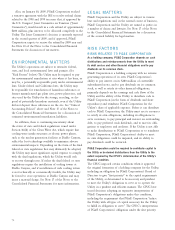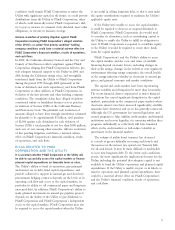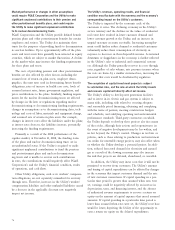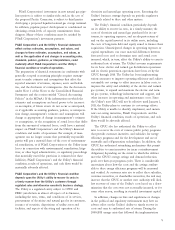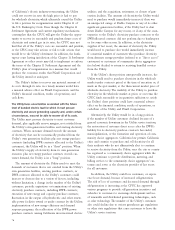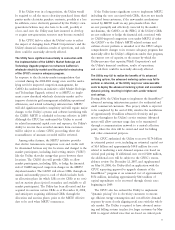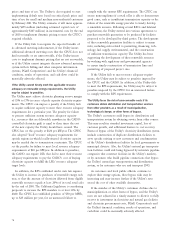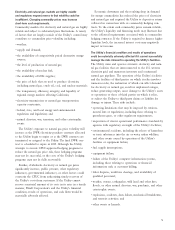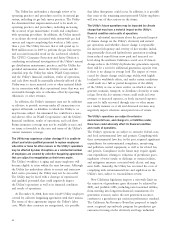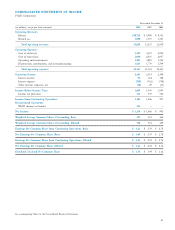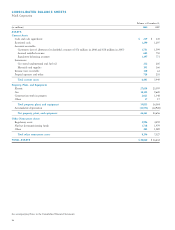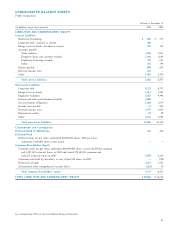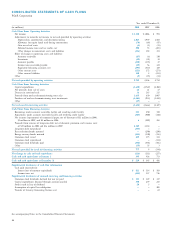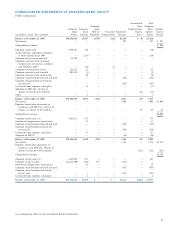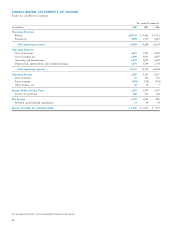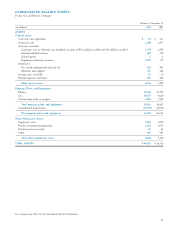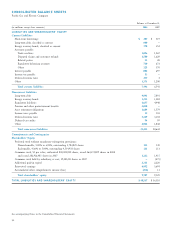PG&E 2008 Annual Report Download - page 83
Download and view the complete annual report
Please find page 83 of the 2008 PG&E annual report below. You can navigate through the pages in the report by either clicking on the pages listed below, or by using the keyword search tool below to find specific information within the annual report.81
to the regulatory, technological, and fi nancial aspects of
decommissioning nuclear plants when their licenses expire.
The Utility maintains insurance and decommissioning
trusts to reduce the Utility’s fi nancial exposure to these
risks. However, the costs or damages the Utility may incur
in connection with the operation and decommissioning
of nuclear power plants could exceed the amount of the
Utility’s insurance coverage and other amounts set aside for
these potential liabilities. In addition, as an operator of two
operating nuclear reactor units, the Utility may be required
under federal law to pay up to $235 million of liabilities
arising out of each nuclear incident occurring not only
at the Utility’s Diablo Canyon facility, but at any other
nuclear power plant in the United States.
The NRC has broad authority under federal law
to impose licensing and safety-related requirements upon
owners and operators of nuclear power plants. If they do
not comply, the NRC can impose fi nes or force a shutdown
of the nuclear plant, or both, depending upon the NRC’s
assessment of the severity of the situation. NRC safety and
security requirements have, in the past, necessitated substan-
tial capital expenditures at Diablo Canyon and additional
signifi cant capital expenditures could be required in the
future. In addition, as required by NRC regulations, only
certain key management personnel and other designated
individuals may receive information from the NRC or
other government agency relating to Diablo Canyon that
is deemed to be classifi ed by the governmental agency. In
connection with this requirement, the Board of Directors of
PG&E Corporation has adopted a resolution acknowledging
that neither PG&E Corporation nor any director or offi cer
of PG&E Corporation will (1) have access to such classifi ed
information or special nuclear material in the custody of
the Utility, or (2) participate in any decision or matter per-
taining to the protection of classifi ed information and/or
special nuclear material in the custody of the Utility. If one
or both units at Diablo Canyon were shut down pursuant to
an NRC order, or to comply with NRC licensing, safety, or
security requirements, or due to other safety, or operational
issues, the Utility’s operating and maintenance costs would
increase. Further, such events may cause the Utility to be
in a short position and the Utility would need to purchase
electricity from more expensive sources. In addition, the
Utility’s nuclear power operations are subject to the avail-
ability of adequate nuclear fuel supplies on terms that the
CPUC will fi nd reasonable.
The NRC operating licenses for Diablo Canyon require
suffi cient storage capacity for the radioactive spent fuel it
produces. Because the U.S. Department of Energy has failed
to develop a permanent national repository for the nation’s
spent nuclear fuel and high-level radioactive waste produced
by the nation’s nuclear electric generation facilities, the
facility sectors beginning in 2012, and expanding to trans-
portation and natural gas in 2015. Depending on how the
baseline for greenhouse gas emissions level is set and how
the cap-and-trade market system develops, the Utility could
incur signifi cant additional costs to ensure that it complies
with the new rules as a generation owner. In addition, the
price to procure electricity from other generation providers
will be affected by the costs of compliance with the new
rules. Although these costs are expected to be passed through
to customers, there can be no assurance that the CPUC will
permit full recovery of these costs, especially if costs increase
due to market manipulation.
In addition, the Utility already has signifi cant liabilities
(currently known, unknown, actual, and potential) related
to environmental contamination at current and former
Utility facilities, including natural gas compressor stations
and former manufactured gas plants, as well as at third-party-
owned sites. The CPUC has established a special ratemaking
mechanism under which the Utility is authorized to recover
90% of environmental costs associated with the clean-up
of sites that contain hazardous substances (subject to some
exceptions) without a reasonableness review. There is no
guarantee that the CPUC will not discontinue or change
this ratemaking mechanism in the future.
The Utility’s environmental compliance and remediation
costs could increase, and the timing of its future capital
expenditures may accelerate, if standards become stricter, reg-
ulation increases, other potentially responsible parties cannot
or do not contribute to cleanup costs, conditions change, or
additional contamination is discovered. If the Utility must
pay materially more than the amount that it currently has
accrued on its Consolidated Balance Sheets to satisfy its envi-
ronmental remediation obligations and cannot recover those
or other costs of complying with environmental laws in its
rates in a timely manner, or at all, PG&E Corporation’s and
the Utility’s fi nancial condition, results of operations, and
cash fl ows would be materially adversely affected.
The operation and decommissioning of the Utility’s nuclear
power plants expose it to potentially signifi cant liabilities
and capital expenditures that it may not be able to recover
from its insurance or other source, adversely affecting its
fi nancial condition, results of operations, and cash fl ows.
Operating and decommissioning the Utility’s nuclear power
plants expose it to potentially signifi cant liabilities and
capital expenditures, including not only the risk of death,
injury, and property damage from a nuclear accident, but
matters arising from the storage, handling, and disposal of
radioactive materials, including spent nuclear fuel; stringent
safety and security requirements; public and political oppo-
sition to nuclear power operations; and uncertainties related



